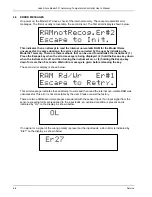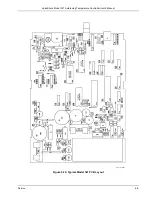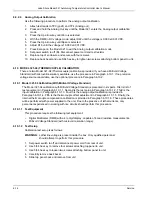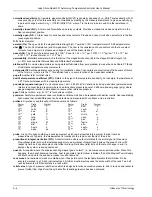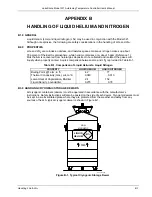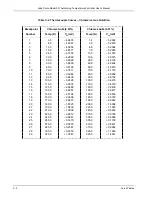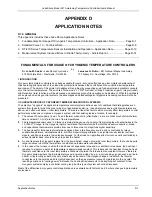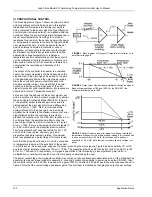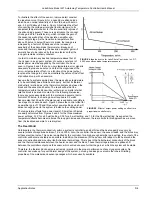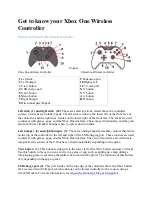
Lake Shore Model 321 Autotuning Temperature Controller User’s Manual
A-2
Glossary of Terminology
asphyxiant gas
. A gas which has little or no positive toxic effect but which can bring about unconsciousness and death
by displacing air and thus depriving an organism of oxygen.
autotuning
. In Lake Shore Temperature Controllers, the Autotuning algorithm automatically determines the proper
settings for Gain (
P
roportional), Reset (
I
ntegral), and Rate (
D
erivative) by observing the time response of the system
upon changes in setpoint.
B
. Symbol for magnetic flux density.
See
Magnetic Flux Density.
bar
. Unit of pressure equal to 10
5
pascal, or 0.98697 standard atmosphere.
baud
. A unit of signaling speed equal to the number of discrete conditions or signal events per second, or the reciprocal
of the time of the shortest signal element in a character.
2
bel (B)
. A dimensionless unit expressing the ration of two powers or intensities, or the ratio of a power to a reference
power, such that the number of bels is the common logarithm of this ratio.
1
bifilar windings
. A winding consisting of two insulated wires, side by side, with currents traveling through them in
opposite directions.
1
bit
. A contraction of the term “binary digit”; a unit of information represented by either a zero or a one.
2
BNC
. Bayonet Nut Connector.
boiling point
. The temperature at which a substance in the liquid phase transforms to the gaseous phase; commonly
refers to the boiling point at sea level and standard atmospheric pressure.
CalCurve Service
. The service of storing a mathematical representation of a calibration curve on an EEPROM or
installed in a Lake Shore instrument. Previously called a Precision Option.
calibration
. To determine, by measurement or comparison with a standard, the correct (accurate) value of each scale
reading on a meter or other device, or the correct value for each setting of a control knob.
1
cathode
. The terminal from which forward current flows to the external circuit.
2
Anode
Cathode
+
–
Carbon-Glass™
. A temperature sensing material fabricated from a carbon-impregnated glass matrix used to make the
Lake Shore CGR family of sensors.
Celsius (°C) Scale
. A temperature scale that registers the freezing point of water as 0 °C and the boiling point as 100 °C
under normal atmospheric pressure. Celsius degrees are purely derived units, calculated from the Kelvin
Thermodynamic Scale. Formerly known as “centigrade.”
See
Temperature for conversions.
Cernox™
. A Lake Shore resistance temperature detector based on a ceramic-oxy-nitride resistance material.
CGR
. Carbon Glass Resistor.
cgs system of units
. A system in which the basic units are the centimeter, gram, and second.
2
Chromel™
. A chromium-nickel alloy which comprises the positive lead of Type E and K thermocouples.
coercive force
(coercive field)
. The magnetic field strength (H) required to reduce the magnetic induction (B) in a
magnetic material to zero.
coercivity
. generally used to designate the magnetic field strength (H) required to reduce the magnetic induction (B) in a
magnetic material to zero from saturation. The coercivity would be the upper limit to the coercive force.
Constantan
. A copper-nickel alloy which comprises the negative lead of Type E, J, and T thermocouples.
cryogen
.
See
cryogenic fluid.
1
cryogenic
. Refers to the field of low temperatures, usually –130 °F or below, as defined by 173.300(f) of Title 49 of the
Code of Federal Regulations.
cryogenic fluid
. A liquid that boils at temperatures of less than about 110 K at atmospheric pressure, such as hydrogen,
helium, nitrogen, oxygen, air, or methane. Also known as cryogen.
1
cryostat
. An apparatus used to provide low-temperature environments in which operations may be carried out under
controlled conditions.
1
Curie temperature (Tc)
. Temperature at which a magnetized sample is completely demagnetized due to thermal
agitation. Named for Pierre Curie (1859 – 1906), a French chemist.
current source
. A type of power supply that supplies a constant current through a variable load resistance by
automatically varying its compliance voltage. A single specification given as “compliance voltage” means the output
current is within specification when the compliance voltage is between zero and the specified voltage.
curve
. A set of data that defines the temperature response of a temperature sensor. It is used to convert the sensor's
signal to temperature.
Curve 10
. The voltage versus temperature characteristic followed by all DT-400 Series Silicon Diode Temperature
Sensors.
decibels (dB)
. A unit for describing the ratio of two powers or intensities, or the ratio of a power to a reference power;
equal to one-tenth bel; if P
1
and P
2
are two amounts of power, the first is said to be
n
decibels greater, where
n
= 10 log
10
(P
1
/P
2
).
1

